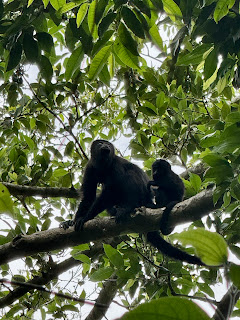Field Note – A Hopeful Encounter at Runaway Creek
Field Note – A Hopeful Encounter at Runaway Creek
Date: 2025/6/23
Location: Runaway Creek Nature Reserve, Belize
Today, we set out to explore Runaway Creek Natural Reserve in hopes of spotting Black Howler Monkeys. Dr. Kayla Hartwell, who has been researching both howler and spider monkeys for years at Monkey Bay Sanctuary, joined us and shared some of the background behind their ongoing conservation efforts.
Howler monkeys used to live alongside spider monkeys in this area without much trouble—mainly because howlers eat mostly leaves, while spider monkeys prefer fruit. But after a series of hurricanes and forest fires, fruit became scarce. As a result, spider monkeys started eating more leaves, creating unexpected competition with howlers. Over time, howlers began to disappear, and the last confirmed sighting was in 2015. Later, researchers even found howler monkey bones in the area, suggesting the population may have gone locally extinct due to this shift in resource use.
Since the COVID-19 pandemic, Dr. Hartwell and her team have worked with the Belize Forest Department and local wildlife organizations to reintroduce howlers through a soft release program. The rescued monkeys—mainly former illegal pets—are first kept in a fenced area to adjust to the forest environment before being released. These sites are chosen carefully to avoid spider monkeys’ core territories, helping reduce conflict.
After a 20-minute hike uphill, we reached a forested area near a cave—and to our excitement, we spotted two female howler monkeys. Even more exciting, each of them had two baby boys! Dr. Hartwell explained that these females likely entered their reproductive cycle at the same time, so the babies were probably born around the same time too. She mentioned she’s hoping for more female infants in the future, since they’re especially important for helping the population grow.
A little later, we also saw two juvenile males nearby, moving through the trees. It was a hopeful moment—seeing signs of new life and knowing that the reintroduction efforts are starting to work. Hopefully, we’ll be seeing even more of them in the future.





Comments
Post a Comment